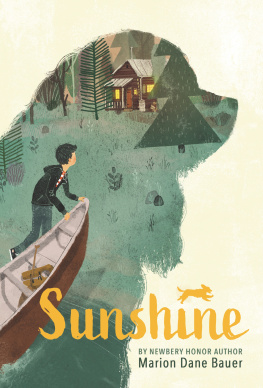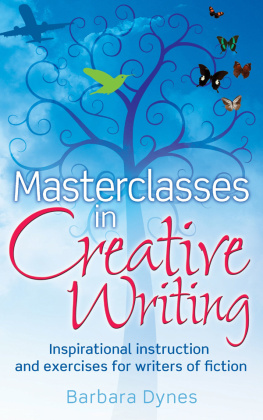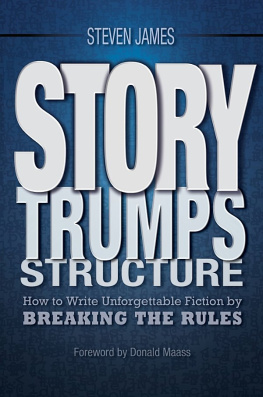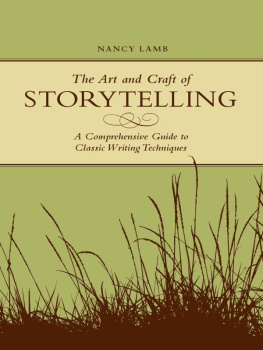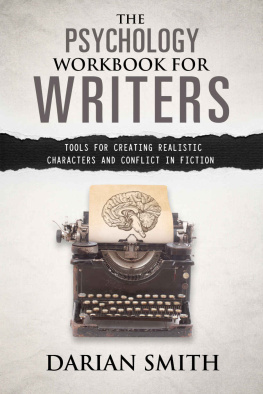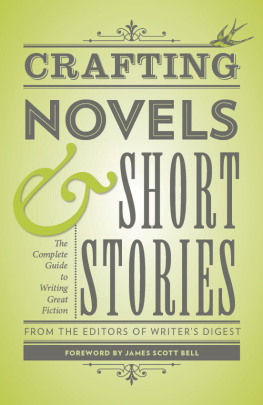Clarion Books
a Houghton Mifflin Harcourt imprint
3 Park Avenue, New York, NY 10016
Text copyright 1992 by Marion Dane Bauer
All rights reserved.
For information about permission to reproduce selections from this book, write to or to Permissions, Houghton Mifflin Harcourt Publishing Company, 3 Park Avenue, 19th Floor, New York, New York 10016.
hmhbooks.com
The Library of Congress has cataloged the print edition as follows:
Bauer, Marion Dane.
Whats your story? : a young persons guide to writing fiction / by Marion Dane Bauer.
p. cm.
Summary: Discusses how to write fiction, exploring such aspects as character, plot, point of view, dialogue, endings, and revising.
ISBN 0-395-57781-0 PA ISBN 0-395-57780-2
1. Short storyJuvenile literature. 2. FictionAuthorshipHandbooks, manuals, etc.Juvenile literature. 3. Children as authors. [ 1. Fictionauthorship. 2. Creative writing.]
I. Title.
PN3373.B25 1992
808.31dc20 91-3816
CIP
AC
eISBN 978-0-547-53168-7
v2.1119
For my editor,
James Cross Giblin,
with affection and appreciation,
because every story I write
is deeper, truer, stronger
for passing through his hands
Introduction
We are born hungry. We are hungry for food, for warmth, for a loving touch, and for something else as well. We are hungry to understand, to make sense of the world around us. Almost as soon as we begin to talk, we ask a single question, over and over again. Why? And we are still asking that same question when we say, only slightly later, Tell me a story.
Human beings are storytelling animals. Thats what separates us from other creatures, not just having thumbs or using tools.
Stories help us to make sense of our world. They teach us what is possible. They let us know that others before us have struggled as we do. If Hansel and Gretel can escape the wicked witch, so can we. If the poor prince is rewarded for his kindness, then we might be, too.
So from an early age, we begin to shape our own world by telling stories ourselves. Ill be the mother and you be the father and this is our house and... Or, Once upon a time, there was a boy who hated his little sister. It wasnt me. It was some other boy who had a little sister. Our stories put us in charge. They allow us to explore our feelings without having to face the consequences of acting them out. They help us understand what it means to be a human being.
Creating stories is important work for the professional writer. It is as important as building highways or selling shoes or making laws. And we each have our own stories to tell, whether we are professional writers or not. Even when we are very youngperhaps especially when we are very youngstories bubble inside us. When we share them with others, we discover that they are usually eager to hear them.
Where do storytellers find the wisdom to discover their own stories, the ones others are longing to hear? From no place more mysterious than their own hearts. Thus, the first thing we must know before we can begin to write a story is ourselves. We dont need to understand every crevice and corner. No one ever does, no matter how long we live. But we must understand some of our own truths. What ideas excite us? What makes us laugh... or cry? What are we struggling to understand?
Learning to tell a good story is hard work. Learning to write one, refining our words for an audience we will never see, is harder still. Its at least as hard as learning to ski or to play a musical instrument. But writing stories can be the kind of work that makes us glad to be alive. It stretches our mental muscles and leaves us feeling excited and proud. It can be work we love to do.
Youd love to write a story? Wonderful. Lets begin.
Chapter 1
The First Step... A Story Plan
Many people want to write stories. Many more people want to write them than ever get around to doing it. That is partly because stories take time. They take time to grow in the authors mind, time to write down, and time to rework until they are ready to be read.
Everyones day has the same number of hours. If you want to do something special like writing a story, you must make time just for that. And making time usually means taking it from some other part of your life. Turn off the television set. Practice writing thirty minutes a day instead of playing the marimba. Organize your homework or your bedtime ritual more efficiently. A story isnt a gift delivered while you are thinking about something else. It is a project you will need to work on with thought and care.
Thus, the first part of creating a story plan is making a plan for yourself. When will you write? Where? How often? For how long? Choose a time that is regular and one that is right for you. Are you going to set your alarm early and work from five to seven A.M. every day? Unless you are a very unusual person, such a plan probably wont last beyond the first morning. Decide what is realistic for you. Ask yourself, also, how much writing time you can enjoy. Thirty minutes a day? Fifteen? Two hours on weekends? Then make story writing a pleasant habit in your life.
If you find yourself brushing the cat or even offering to wash the dishes during the time youve set aside for writing, reconsider. Do you really want to write a story, or do you want to have written one? The two are very different.
But, you say, you do want to write a story. Then begin by finding a place in your life where writing time fits, comfortably and regularly, like practicing the piano or pressing weights. And then make that time work for you. You will achieve far more by writing fifteen minutes a day than you will by waiting for that mythical future when you are going to have nothing else to do.
What Is a Story?
We all have read hundreds of stories and have had them read to us as well, probably since we were very small. However, most of us can feel what a story is better than we can explain it. Creating something that matches this feeling can be difficult.
Lets try this definition: A story, any story, is about someone struggling. The main character must have a problem he has to struggle to solve, or he must want something he has to struggle to get. If there is no struggle, there is, quite simply, no story.
(The term that is often used for this struggle in fiction is conflict. I prefer the word struggle, because the idea of struggle implies that the main character is active. Too many stories by beginning writers fail because they have a main character who is passive in the face of a conflict.)
The definition I have given fits the shortest short stories and the longest novels. The difference between the two lies in complexity and, of course, length. Much of what I will be discussing fits either, but most writers begin with short stories. They are more manageable for learning on.
For one thing, if you begin by working on short stories, you can have the satisfaction, and the good experience, of finishing many different ones. New writers who launch into a novel often get lost along the way and never finish even one.
For another, the short story is simpler; the characters are fewer and the story lines clearer. As you work on a shorter piece, it will be much easier to keep track of the different parts.
So even though I will sometimes give examples from my own novelsand even though most of what I will say applies equally to novelsthis guide is designed primarily to help you plan and write a short story.
A Writers Notebook
The core of any story plan is an idea that involves someone struggling toward something. Sound simple? It is. However, if you asked me to come up with an idea for a new story right now, I would probably be pretty blank. And the more anxiously you waited for results, the blanker I would be apt to feel. What I need in this early stage, and what you will need as well, is time. Time to think, to remember, to observe.


